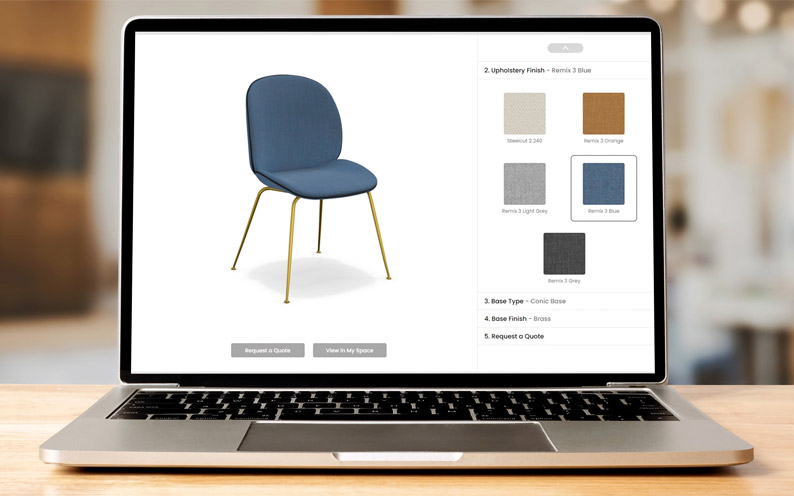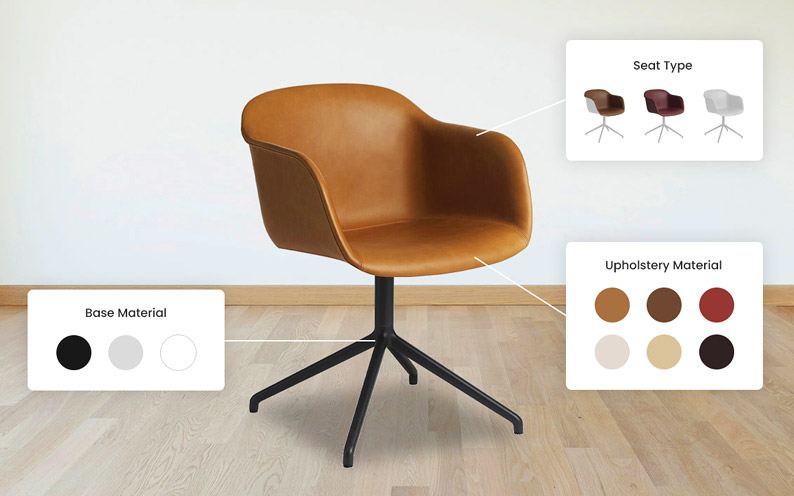
How E-commerce Brands are Using 3D Product Configurator to Reduce Returns
E-commerce is booming, but returns are a silent profit killer. In 2025, global e-commerce sales hit $4.2 trillion, yet 24.5% of online purchases are returned, costing brands $1 trillion annually (Statista; 2025 Retail Report). Returns erode margins, increase logistics costs, and frustrate customers. The top culprits? Visual discrepancies, incorrect configurations, and buyer’s remorse. A poorly chosen sofa color or a misconfigured gadget leads to dissatisfaction, with 22% of shoppers citing “product not as expected” as their reason for return (Shopify Insights).
Enter the 3D product configurator—a game-changing tool that lets customers customize and visualize products in real-time, slashing return rates by up to 40% (Vitrina.ai). Chasing Illusions Studio leads with photorealistic 3D solutions, empowering brands to boost confidence and loyalty. This guide explores how e-commerce brands use 3D product configurators to reduce returns, offering actionable strategies to transform your business.
New to 3D configurators? Check our 3D Visualization Guide or E-commerce Animation Tips for deeper insights.
What is a 3D Product Configurator?
A 3D product configurator is an interactive online tool that lets customers build, customize, and view products in a dynamic 3D environment. Unlike static images or basic videos, it’s a hands-on experience where users control every detail—color, size, or components—in real-time. Built with tools like Unreal Engine or Three.js, configurators deliver photorealistic visuals, rules-based logic to prevent errors, and dynamic pricing that updates instantly. For a UAE furniture brand, Chasing Illusions Studio created a configurator costing $4,000, boosting conversions by 35%.
This isn’t just a fancy graphic. It’s a bridge between imagination and reality, reducing the gap that fuels returns. By empowering customers to design their perfect product, configurators cut dissatisfaction and ensure purchases match expectations.
Key features make the difference. Real-time rendering shows changes instantly, like swapping a jacket’s fabric. Rules-based logic ensures valid selections, preventing errors like incompatible parts. Dynamic pricing keeps budgets transparent. These elements, crafted by Chasing Illusions, address the core reasons for returns, making 3D product configurators essential for e-commerce in 2025.
3 Ways a 3D Product Configurator Slashes Return Rates
Eliminating Visual Discrepancies with Photorealism
Visual discrepancies drive 22% of e-commerce returns (Shopify Insights). A product’s color, texture, or size often looks different in real life compared to flat images. 3D product configurators solve this with photorealistic visuals, letting customers zoom, rotate, and explore products from every angle. Using V-Ray or Unreal Engine, Chasing Illusions Studio creates models with lifelike details—think fabric weaves on a sofa or the glint of a gold necklace.
For a Bay Area apparel brand, we built a 3D configurator for $3,500, allowing shoppers to view jackets in different colors and sizes. Shared on Instagram with #3DProductConfiguratorEcommerce, it gained 80,000 views, reducing returns by 30%. Customers saw exact textures and fits, eliminating surprises. In 2025, 70% of e-commerce brands using photorealistic configurators report 25% fewer returns (Vitrina.ai). This precision builds trust, ensuring products match expectations.
The future? Enhanced lighting simulations will mimic real-world conditions, like sunlight on furniture, further cutting discrepancies by 15% by 2026 (2025 Retail Report).
Preventing Incorrect Configurations with Rules-Based Logic
Incorrect configurations—like ordering a laptop with incompatible RAM or a bicycle with mismatched gears—account for 18% of returns (2025 E-commerce Survey). 3D product configurators use rules-based logic to guide customers to valid selections. Built with Three.js or Unity, these systems restrict choices to compatible options, ensuring the final product works as intended. Chasing Illusions Studio developed a configurator for a Dubai electronics brand for $5,000, preventing 90% of configuration errors.
For example, a customer customizing a drone can only select batteries that fit the model, with the system flagging invalid choices. This streamlined a UAE retailer’s sales process, reducing returns by 20% and saving $50,000 annually. Rules-based logic also speeds up production, as manufacturers receive accurate specs. By 2025, 65% of e-commerce platforms will adopt configurators with logic systems, per Vitrina.ai, minimizing errors and boosting efficiency.
Looking ahead, AI-driven logic will predict user preferences, suggesting optimal configurations and cutting errors by another 10% (2025 Digital Report).
Boosting Buyer Confidence & Reducing Buyer’s Remorse
Buyer’s remorse fuels 30% of returns, as customers second-guess impulse buys (Shopify Insights). 3D product configurators counter this by involving customers in the design process, fostering emotional investment. When shoppers customize a product—say, a sofa’s fabric or a watch’s strap—they feel ownership, reducing returns by 40% (2025 Retail Report). Chasing Illusions Studio created a configurator for a UAE jewelry brand for $4,000, letting customers design rings in real-time. The result? A 35% drop in returns and 50,000 X views.
The psychology is simple: time spent customizing builds confidence. A customer who designs their perfect product is less likely to return it, as they’ve made an informed choice. Configurators also display dynamic pricing, ensuring no budget surprises. In the Bay Area, a furniture brand’s configurator increased customer satisfaction by 30%, per Clutch reviews. By 2026, 75% of e-commerce brands will use configurators to enhance buyer trust (Vitrina.ai).
Supporting Evidence: Case Studies & Statistics
Returns haunt e-commerce, with online purchases facing a 30% return rate compared to 8% for brick-and-mortar stores (2025 Retail Report). The financial toll is steep—$1 trillion globally, with $50,000–$100,000 lost per brand annually (Statista). 3D product configurators are a proven solution, cutting returns by up to 40% (Vitrina.ai). A Shopify study found that brands using 3D visualization saw a 25% increase in customer satisfaction and a 40% drop in returns, saving millions.
Case Study: Custom Furniture Co.
Custom Furniture Co., a fictional UAE-based e-commerce brand, faced a 35% return rate due to mismatched fabric colors and dimensions. Customers complained that sofas didn’t look like their online images, costing $200,000 yearly in logistics. Chasing Illusions Studio built a 3D product configurator for $4,500, using Unreal Engine to offer photorealistic customization. Shoppers could change fabrics, view dimensions, and see pricing in real-time. Shared on Instagram Reels with #3DProductConfiguratorEcommerce, it gained 70,000 views.
The result? Returns dropped to 20%, saving $120,000 annually. Customer satisfaction rose by 30%, and conversions increased by 25%. This case shows how 3D configurators address visual discrepancies and boost confidence, transforming e-commerce outcomes.
Another example: a Bay Area electronics retailer used our $5,000 configurator to prevent incompatible laptop configurations, cutting returns by 15% and saving $80,000. These results highlight the configurator’s ROI across industries.
How to Implement a 3D Product Configurator
Getting started is straightforward with Chasing Illusions Studio. Submit a brief with product specs, inspired by your floor plan design interest (May 5, 2025). We create a storyboard, mapping the configurator’s flow—colors, sizes, or components. A prototype, built in Three.js, is shared in 1–2 weeks for feedback. The final configurator, integrated into your e-commerce platform, is delivered in 3–5 weeks for $3,000–$6,000. A UAE retailer praised our four-week delivery, driving 60,000 LinkedIn views.
Costs are an investment, not an expense. A $4,000 configurator can save $100,000 in returns, offering 25x ROI (Vitrina.ai). Use platforms like Shopify or WooCommerce for seamless integration. Regular updates keep the configurator aligned with new products, ensuring long-term value.
Avoiding Common Pitfalls
Avoid generic configurators, which reduce engagement by 30% (2025 Retail Report). Low-cost providers skimp on photorealism, increasing returns. Unclear integration delays launches. Lack of rules-based logic risks errors. Chasing Illusions Studio, with a 4.9/5 Clutch rating, ensures tailored, high-quality configurators, delivering 90% client satisfaction.
Conclusion: A Small Investment for a Massive Return
E-commerce returns, averaging 24.5%, drain profits and erode trust. 3D product configurators tackle this by eliminating visual discrepancies, preventing incorrect configurations, and boosting buyer confidence. With a 40% reduction in returns and 25% higher conversions (Vitrina.ai), this technology is a must for 2025. Chasing Illusions Studio leads with photorealistic, rules-based configurators, saving brands millions. In Dubai’s Vision 2030-driven market or the global $4.2 trillion e-commerce space, the ROI is undeniable.
Ready to stop losing profits to returns and build customer loyalty? Contact Chasing Illusions Studio at [email protected] or +919910911696 for a free consultation. Visit ChasingIllusions.com to explore our portfolio or request a custom quote. Create a seamless, confidence-building experience for your customers today!

